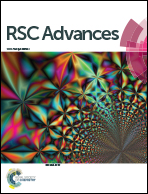Simple synthesis of MoO2/carbon aerogel anodes for high performance lithium ion batteries from seaweed biomass†
Abstract
The sluggish kinetics and large volume expansion occurring during cycle process are critical disadvantages for molybdenum dioxide (MoO2) based anode materials for lithium-ion batteries (LIBs). The design and controllable synthesis of MoO2 based materials with unique hierarchical structure are desired. In this work, we present a one step in situ method to synthesize MoO2/carbon aerogel composites with MoO2 nanoparticles embedded in the carbon aerogel matrix using an environmentally friendly alginate as the carbon precursor. The key feature of our strategy involves the use of a carbon aerogel matrix which facilitates the Li ion transport and offers the space for MoO2 volume expansion during the discharge and charge processes. The composite prepared under optimum conditions, namely a stabilization temperature at 375 °C, exhibited a brilliant performance with a specific capacity of 574 mA h g−1 at a current density of 100 mA g−1, good cycle stability (i.e., a reversible capacity of 490 mA h g−1 at a current density of 200 mA g−1 for 120 cycles), excellent rate capability (remains at 331 mA h g−1 even at a current density of 1000 mA g−1). This finding presents an easy, eco-friendly and efficient strategy for the fabrication of potential high-performance LIBs anodes.


 Please wait while we load your content...
Please wait while we load your content...